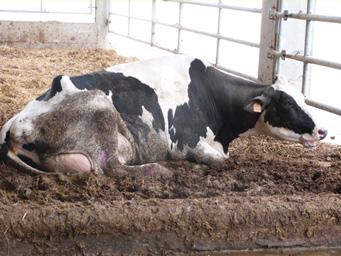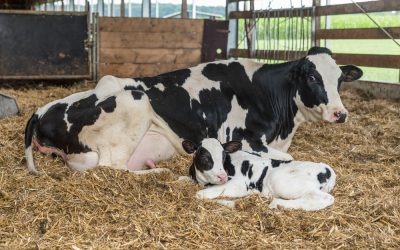X.Manteca, E.Mainau, D.Temple
The dry period is critically important for the welfare of dairy cows and their production in the following lactation. The main welfare problems during the dry period are an increased risk of intramammary infections, pain and discomfort due to udder engorgement, feed and water restriction and aggressive interactions between cows. The following figure summarizes some of these problems.

INCREASED RISK OF INTRAMAMMARY INFECTIONS
Several studies have shown that over 60% of new intramammary infections occur during the dry period and the vast majority of them are caused by environmental pathogens. There are two phases within the dry period when susceptibility to new intramammary infections is particularly high: shortly after drying off and just before calving.
Several factors increase the risk of new intramammary infections. Once milking stops there is neither flushing of bacteria from the streak canal or teat dip protection. Udder engorgement due to the abrupt cessation of milking at drying off (see below) may cause milk leakage, delays the formation of the keratin plug and results in widening and shortening of the streak canal. In addition, milk is a perfect substrate for bacterial growth.
Shortly before calving, susceptibility to infection increases because the keratin plug breaks down, leukocyte function is impaired and there is colostrum leakage in some cows.

Dried cow lying on a dirty area
Mastitis are a major welfare problem mainly because they cause pain. There is now behavioural and physiological evidence showing that all clinical mastitis are painful. For example, it has been shown that cows with mild and moderate mastitis have significantly larger hock-to-hock distances compared with healthy cows, suggesting that they modify their stance to reduce pressure on the udder. Also, cows with mild and moderate mastitis show an increased sensitivity to pressure on the leg closes to the affected quarter, which would indicate a lower pain threshold as a result of the inflammatory process.
Providing adequate resting places for cows and keeping them clean, dry and comfortable is critical to reduce the risk of new intramammary infections. Assessing cow cleanliness can be a useful tool to identify possible housing or husbandry problems that may compromise udder health. The Welfare Quality® protocol to assess the welfare of dairy cows includes cow cleanliness as one of several indicators. According to the Welfare Quality® protocol, cleanliness is assessed on the udder, the lower hind legs and the hind quarters of the cows, and 3 levels are considered from a welfare point of view: no problem, moderate problem and serious problem. For the assessment to be meaningful a significant number of cows have to be assessed and the minimum number will depend on herd size.
DISCOMFORT AND PAIN CAUSED BY UDDER ENGORGEMENT AT DRYING-OFF
Drying-off in modern dairy farming is carried out between 45 and 60 days before the expected time of parturition and involves the abrupt cessation of milking of cows that are still producing considerable amounts of milk (up to 50 L per day in some cases). Drying-off results therefore in the accumulation of massive amounts of milk in the udder, leading to udder engorgement, which is particularly pronounced in high yielding cows. Udder engorgement at drying-off causes discomfort and pain.
There are two lines of evidence that demonstrate that a significant proportion of cows experience udder pain after drying off: lying behaviour and behaviour in response to udder manipulation. Dairy cows are strongly motivated to lie down for long periods of time and it has been demonstrated that cows reduce their lying time after drying off as a result of udder pain, probably in an attempt to relieve pressure on the udder. Additionally, many cows show signs of pain when their udder is touched shortly after drying off. Available evidence indicates that between 10 and 20 % of cows suffer pain as a result of udder engorgement and in 6% of the animals, udder pain was intense. If this percentage is extrapolated to the total number of dairy cows in the European Union (around 23 million cows), then it has to be concluded that between 2.5 and 4.6 million cows experience udder pain as a result of drying off.
As it has already been explained, drying off is also a period of increased risk for new intramammary infections. Stress is known to increase the susceptibility of animals to infectious diseases and therefore, the stressful nature of drying off (which is to a significant extent caused by udder engorgement and pain) is likely to further increase the risk of yet another welfare problem (e.g. intramammary infections).
“DRYING-OFF IS A PAINFUL AND STRESSFUL PERIOD”
RESTRICTED ACCESS TO FEED AND WATER AT DRYING OFF
Restriction of feed and especially water intake is sometimes used as a method to quickly cease milk production. Abruptly restricting feed and water intake has been associated with an increase in cortisol, which is an indicator of stress. Furthermore, restricting access to water raises severe welfare concerns.
AGGRESSIVE INTERACTIONS AND COMPETITION BETWEEN COWS
As calving approaches, cows are likely to be moved to a new pen and mixed with other cows. Re-grouping may occur several times during the last few weeks of pregnancy. There are several studies showing that regrouping reduces time spent ruminating and increases aggression.
Individual cows respond differently to regrouping and this may have important effects on their health status after calving. It has been shown, for example, that cows that develop metritis and ketosis after calving spent less time feeding during the pre-calving period than those cows that remain healthy after calving. It has been suggested that subordinate cows may be particularly at risk as they would be driven away from the feed bunk by more dominant cows. Therefore, providing enough feeding space would be particularly important to reduce the negative effects of competition between cows.
SUMMARY
Cows may face several welfare problems during the dry period, including an increased risk of intramammary infections, pain and discomfort caused by udder engorgement after drying off and stress due to regrouping and competition. These welfare problems are likely to have negative effects on health and performance. Good husbandry practices, such as providing cows with a clean, comfortable environment, and avoiding competition as much as possible when regrouping, are critically important strategies to improve the welfare of cows during the dry period. Additionally, reducing udder engorgement after drying off would be very useful to reduce pain and discomfort, as well as the risk of new intramammary infections.
REFERENCES
- Agenäs S, Dahlborn K, Holtenius K. Changes in metabolism and milk production during and after feed deprivation in primiparous cows selected for different milk fat content. Livestock Production Science 2003, 83: 153-164.
- Bertulat S, Fischer-Tenhagen C, Suthar V, Möstl E, Isaka N, Heuwieser W. Measurement of fecal glucocorticoid metabolites and evaluation of udder characteristics to estimate stress after sudden dry-off in dairy cows with different milk yields. Journal of Dairy Science 2013, 96: 3774-3787.
- Dingwell RT, Leslie KE, Schukken YH, Sargeant JM, Timms LL, Duffield TF, Keefe GP, Kelton DF, Lissemore KD, Conklin J. Association of cow and quarter-level factors at drying-off with new intramammary infections during the dry period. Preventive Veterinary Medicine 2004, 63: 75-89.



